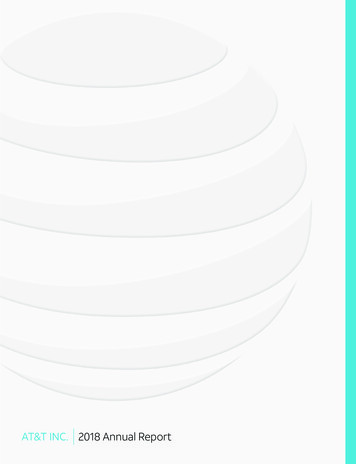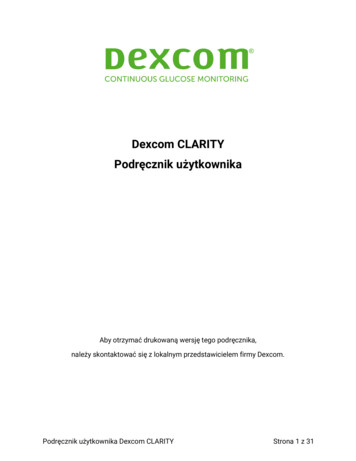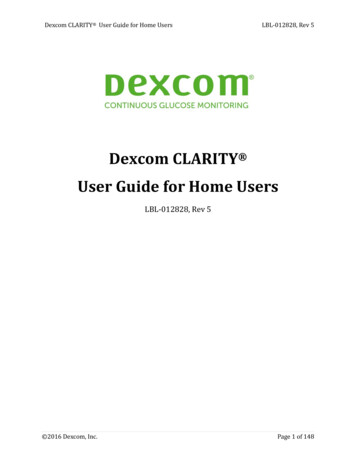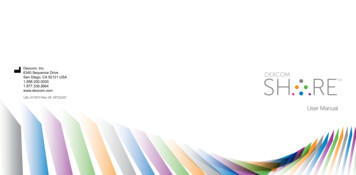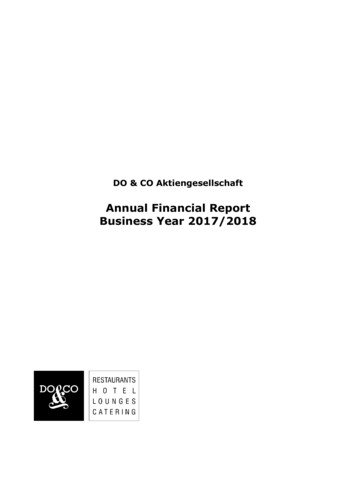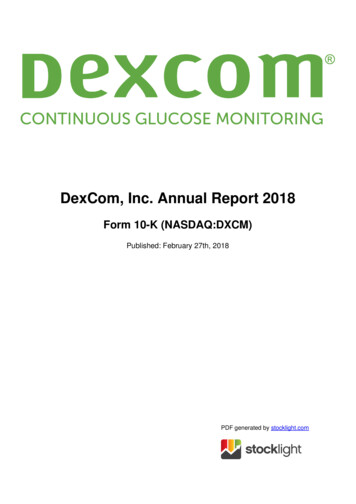
Transcription
DexCom, Inc. Annual Report 2018Form 10-K (NASDAQ:DXCM)Published: February 27th, 2018PDF generated by stocklight.com
UNITED STATESSECURITIES AND EXCHANGE COMMISSIONWashington, DC 20549FORM 10-KýANNUAL REPORT PURSUANT TO SECTION 13 OR 15(d) OF THE SECURITIES EXCHANGE ACT OF1934For the fiscal year ended December 31, 2017 TRANSITION REPORT PURSUANT TO SECTION 13 OR 15(d) OF THE SECURITIES EXCHANGE ACT OF1934For the transition period fromtoCommission file number 000-51222DEXCOM, INC.(Exact name of Registrant as specified in its charter)Delaware33-0857544(State or Other Jurisdiction ofIncorporation or Organization)(I.R.S. EmployerIdentification No.)6340 Sequence DriveSan Diego, California92121(Address of Principal Executive Offices)(Zip Code)Registrant’s Telephone Number, including area code: (858) 200-0200Securities registered pursuant to Section 12(b) of the Exchange Act:Act.Title of Each ClassName of Each Exchange on Which RegisteredCommon Stock, 0.001 Par Value Per ShareThe Nasdaq Stock Market LLC(Nasdaq Global Select Market)Securities registered pursuant to Section 12(g) of the Exchange Act: NoneIndicate by check mark if the Registrant is a well-known seasoned issuer, as defined in Rule 405 of the SecuritiesYes ýNo Yes No ýYes ýNo Yes ýNo Indicate by check mark if the Registrant is not required to file reports pursuant to Section 13 or 15(d) of theExchange Act.Indicate by check mark whether the Registrant (1) has filed all reports required to be filed by Section 13 or 15(d)of the Securities Exchange Act of 1934 during the preceding 12 months (or for such shorter period that the Registrantwas required to file such reports), and (2) has been subject to such filing requirements for the past 90 days.Indicate by check mark whether the registrant has submitted electronically and posted on its corporate website, ifany, every Interactive Data File required to be submitted and posted pursuant to Rule 405 of Regulation S-T (§232.405of this chapter) during the preceding 12 months (or for such shorter period that the registrant was required to submitand post such files).Indicate by check mark if disclosure of delinquent filers pursuant to Rule 405 of Regulation S-K is not containedherein, and will not be contained, to the best of Registrant’s knowledge, in definite proxy or information statementsincorporated by reference in Part III of this Form 10-K or any amendment to this Form 10-K. ýIndicate by check mark whether the Registrant is a large accelerated filer, an accelerated filer, a non-acceleratedfiler or a smaller reporting company. See the definitions of “large accelerated filer,” “accelerated filer” and “Smallerreporting company” in Rule 12b-2 of the Exchange Act. (Check one)Large accelerated Filer ý Accelerated Filer Non-accelerated Filer Smaller reporting company Emerging Growth Company If an emerging growth company, indicate by check mark if the registrant has elected not to use the extendedtransition period for complying with any new or revised financial accounting standards provided pursuant to Section13(a) of the Exchange Act. Act).Indicate by check mark whether the Registrant is a shell company (as defined in Rule 12b-2 of the ExchangeYes No ýAs of June 30, 2017, the aggregate market value of the registrant’s common stock held by non-affiliates of the
registrant was approximately 6,243,418,847 based on the closing sales price as reported on the Nasdaq GlobalSelect Market.Indicate the number of shares outstanding of each of the issuer’s classes of common stock, as of the latest practicabledate.ClassOutstanding at February 23, 2018Common stock, 0.001 par value per share86,997,158DOCUMENTS INCORPORATED BY REFERENCEPortions of the documents listed below have been incorporated by reference into the indicated parts of this report,as specified in the responses to the item numbers involved.
Designated portions of the Proxy Statement relating to the 2017 Annual Meeting of the Stockholders ( “ProxyStatement”): Part III (Items 9, 10, 11, 12, and 13). Except with respect to information specifically incorporated byreference in the Form 10-K, the Proxy Statement is not deemed to be filed as part hereof.
DexCom, Inc.Table of ContentsPageNumberPART IITEM 1.Business4ITEM 1A.Risk Factors22ITEM 1B.Unresolved Staff Comments52ITEM 2.Properties52ITEM 3.Legal Proceedings52ITEM 4.Mine Safety Disclosures53Market for Registrant’s Common Equity, Related Stockholder Matters and IssuerPurchases of Equity Securities53ITEM 6.Selected Financial Data54ITEM 7.Management’s Discussion and Analysis of Financial Condition and Results ofOperations55ITEM 7A.Quantitative and Qualitative Disclosures about Market Risk62ITEM 8.Consolidated Financial Statements and Supplementary Data63ITEM 9.Changes in and Disagreements with Accountants on Accounting and FinancialDisclosure63ITEM 9A.Controls and Procedures63ITEM 9B.Other Information66ITEM 10.Directors, Executive Officers and Corporate Governance67ITEM 11.Executive Compensation67ITEM 12.Security Ownership of Certain Beneficial Owners and Management and RelatedStockholders Matters67ITEM 13.Certain Relationships and Related Transactions, and Director Independence67ITEM 14.Principal Accounting Fees and Services67ITEM 15.Exhibits, Financial Statement Schedules68ITEM 16.Form 10-K Summary73PART IIITEM 5.PART IIIPART IV
CAUTIONARY NOTE REGARDING FORWARD-LOOKING STATEMENTSExcept for historical financial information contained herein, the matters discussed in this Form 10-K may beconsidered forward-looking statements within the meaning of Section 27A of the Securities Act of 1933, as amended,and Section 21E of the Securities Exchange Act of 1934, as amended, and subject to the safe harbor created by theSecurities Litigation Reform Act of 1995. Such statements include declarations regarding our intent, belief, or currentexpectations and those of our management. Prospective investors are cautioned that any such forward-lookingstatements are not guarantees of future performance and involve a number of risks, uncertainties and other factors,some of which are beyond our control; actual results could differ materially from those indicated by such forwardlooking statements. Important factors that could cause actual results to differ materially from those indicated by suchforward-looking statements include, but are not limited to: (i) that the information is of a preliminary nature and may besubject to further adjustment; (ii) those risks and uncertainties identified under “Risk Factors”; and (iii) the other risksdetailed from time-to-time in our reports and registration statements filed with the Securities and ExchangeCommission, or SEC. Except as required by law, we undertake no obligation to revise or update publicly any forwardlooking statements, whether as a result of new information, future events or otherwise.
PART IITEM 1.BUSINESSOverviewWe are a medical device company primarily focused on the design, development and commercialization ofcontinuous glucose monitoring, or CGM systems for use by people with diabetes and by healthcare providers. Wereceived approval from the Food and Drug Administration, or FDA and commercialized our first product in 2006 and arecurrently commercializing our fifth generation CGM system. Unless the context requires otherwise, the terms "we,""us," "our," the "company," or "DexCom" refer to DexCom, Inc. and its subsidiaries.ProductsDexCom G5 MobileIn August 2015, we received approval from the FDA for the DexCom G5 Mobile Continuous Glucose MonitoringSystem, also referred to as the G5 Mobile. The G5 Mobile is designed to allow our transmitter to run the Software 505algorithm that historically had operated on the receiver, and to communicate directly to a patient's mobile device,including iPhone , iPod touch , iPad , or certain Android mobile digital devices. The G5 Mobile transmitter has alabeled useful life of three months. Data from the G5 Mobile can be integrated with DexCom CLARITYTM, our nextgeneration cloud-based reporting software, for personalized, easy-to-understand analysis of trends that may improvediabetes management. We previously received CE Mark approval for, and in September 2015 we launched, the G5Mobile in certain countries in Europe.The sensor is inserted by the user and is intended to be used continuously for up to seven days, after which itmay be replaced with a new disposable sensor. Our transmitter is reusable until it reaches the end of its battery life.Our receiver is reusable. As we establish an installed base of customers using our products, we expect to generate anincreasing portion of our revenues through recurring sales of our disposable sensors. In December 2016, the FDAapproved the G5 Mobile as the first CGM system in the United States to have a non-adjunctive indication. The nonadjunctive indication expands the lawfully permitted use of the G5 Mobile as a replacement to finger stick glucosetesting for diabetes treatment decisions. With the new label indication, the G5 Mobile only requires two finger pricks perday for calibration. In the countries and regions outside of the United States that recognize the CE Mark, as well as theUnited States and Canada, the G5 Mobile also does not require confirmatory finger sticks when making treatmentdecisions, although a minimum of two finger sticks a day remain necessary for calibration. Approval of the nonadjunctive indication also was an important and necessary step in enabling people with Medicare to access CGM.Except with respect to the foregoing, the G5 Mobile is equivalent to the G4capabilities and its regulatory requirements and indications. PLATINUM System in its technicalDexCom G4 PLATINUMThe DexCom G4 PLATINUM continuous glucose monitoring system replaced our legacy DexCom SEVEN PLUSsystem beginning in 2012, when it was approved for up to seven days of continuous use by adults with diabetes. Since2012, we have marketed the DexCom G4 PLATINUM under a Conformité Européenne Marking, or CE Mark, in theEuropean Union, Australia, New Zealand and the countries in Asia and Latin America that recognize the CE Mark, andin the United States with approval from the FDA. We received approvals for a pediatric indication under the CE Mark inFebruary 2013 and from the FDA in February 2014, enabling us to market and sell this system to persons two yearsold and older who have diabetes (hereinafter referred to as the "Pediatric Indication"). In June 2014, we receivedapproval from the FDA for an expanded indication for the DexCom G4 PLATINUM for professional use, which allowshealthcare professionals to purchase the DexCom G4 PLATINUM system for use with multiple patients. Healthcareprofessionals can use the insights gained from a DexCom G4 PLATINUM professional session to adjust therapy andto educate and motivate patients to modify their behavior after viewing the effects that specific foods, exercise, stressand medications have on their glucose levels. In October 2014, we launched our Software 505 for the DexCom G4PLATINUM, an algorithm which enabled our systems to achieve a single digit MARD - a measure of the accuracy ofcontinuous glucose monitoring. We believe our CGM systems are currently the most consistently accurate available forcontinuous glucose monitoring.DexCom Share In 2015, we received approval from the FDA for the DexCom G4 PLATINUM with Share and begancommercializing this product in the United States in the first quarter of 2015 using a secure wireless connectionbetween a patient’s G4 PLATINUM receiver and an app. We now offer this feature directly from the transmitter throughthe G5 Mobile app. The
DexCom Share remote monitoring system uses an app on the patient's iPhone, iPod touch, iPad, Apple Watch TM orAndroid mobile digital device to transmit glucose information to apps on the mobile devices of up to five designatedrecipients, or "followers", who can remotely monitor a patient's glucose information and receive alert notificationsanywhere they have an Internet or cellular connection.Data & Insulin Delivery CollaborationsWe have entered into multiple collaboration agreements that leverage our technology platform to integrate ourcontinuous glucose monitoring products with insulin delivery systems. The general purpose of these development andcommercial relationships is to integrate our technology into the insulin pump or pen product offerings of the respectivepartner, enabling the partner's insulin delivery device to receive and display glucose readings from our transmitter and,in some cases, use the glucose readings for semi-automated insulin delivery. Currently, we have announced insulindelivery partnerships with Beta Bionics, Diabeloop, Eli Lilly, Insulet, Tandem and TypeZero Technologies. In addition tothese major partners, we are working with other companies that are pursuing varying strategies surrounding semiautomated insulin delivery and data analytics to improve outcomes and ease-of-use in diabetes management.Verily CollaborationIn August 2015, we entered into a Collaboration and License Agreement (“Verily Collaboration Agreement”) withGoogle Life Sciences LLC, now named Verily Life Sciences (“Verily”). Pursuant to the Verily Collaboration Agreement,we and Verily have agreed to jointly develop a series of next-generation continuous glucose monitoring products. TheVerily Collaboration Agreement provides us with an exclusive license to use certain intellectual property of Verilyrelated to the development, manufacture and commercialization of the products contemplated under the VerilyCollaboration Agreement. The Verily Collaboration Agreement provides for the establishment of a joint steeringcommittee, joint development committee and joint commercialization committee to oversee and coordinate the parties’activities under the collaboration. We and Verily have agreed to make committee decisions by consensus. Certainamendments were made to this agreement in October 2016.Future ProductsWe plan to develop future generations of technologies focused on improved performance and convenience andthat will enable intelligent insulin administration. We also are aggressively exploring how to extend our product portfolioto other categories of people with diabetes including those with Type 2 diabetes that are non-insulin using, people withpre-diabetes and people who are obese. Over the longer term, we plan to develop networked platforms with openarchitecture, connectivity and transmitters capable of communicating with other devices and software systems. We alsointend to expand our efforts to accumulate CGM patient data and metrics and apply predictive modeling and machinelearning to generate interactive CGM insights that can inform patient behavior.Our product development timelines depend on our ability to achieve clinical endpoints, regulatory and legalrequirements and to overcome technology challenges. Product development timelines may be delayed due to extendedregulatory approval timelines, scheduling issues with patients and investigators, requests from institutional reviewboards, sensor performance and manufacturing supply constraints, among other factors. In addition, support of theseclinical trials requires significant resources from employees involved in the production of our products, includingresearch and development, manufacturing, quality assurance, and clinical and regulatory personnel. Even if ourdevelopment and clinical trial efforts are successful, the FDA may not approve our products, and even if approved, wemay not achieve acceptance in the marketplace by physicians and people with diabetes.BackgroundDiabetes is a disease with significant adverse consequences for human health throughout the world. TheInternational Diabetes Federation, or IDF , estimates that in 2017, 425 million people around the world had diabetes,and the Centers for Disease Control, or CDC , estimates that in 2017, diabetes affected 30.3 million people in theUnited States, of which 7.2 million were undiagnosed. IDF estimates that by 2045, the worldwide incidence of peoplesuffering from diabetes will reach 629 million. According to the CDC's National Vital Statistics Reports for 2015,diabetes was the seventh leading cause of death by disease in the United States. According to the CongressionalDiabetes Caucus website, diabetes is the leading cause of kidney failure, adult-onset blindness, lower-limbamputations, and significant cause of heart disease and stroke, high blood pressure and nerve damage. According tothe IDF, there were an estimated 4 million deaths attributable to diabetes globally in 2017 between the ages of 20 and79 years. The American Diabetes Association, or ADA , Fast Facts, revised in August 2017, states that diabetes is theprimary cause of death for more than 80,000 Americans each year, and contributes to the death of more than 250,000Americans annually. According to an article published in The New England Journal of Medicine in November 2014,excess mortality for people with diabetes with ages of less than 30 years is largely explained by acute complications ofdiabetes.
Among people of all ages, 2015 data indicated the following: An estimated 23.1 million people or 7.2% of the U.S.population had been diagnosed with diabetes. In addition to those newly diagnosed, the Congressional DiabetesCaucus website reports that every 24 hours there are: 238 amputations in people with diabetes, 120 people who enterend-stage kidney disease programs, and 48 people who go blind.According to the ADA, one in every five healthcare dollars was spent on treating diabetes in 2012, and the directmedical costs and indirect expenditures attributable to diabetes in the United States were an estimated 245 billion, anincrease of 71 billion, or approximately 41%, since 2007. Of the 245 billion in overall expenses, the ADA estimatedthat approximately 176 billion were direct costs associated with diabetes care, chronic complications and excessgeneral medical costs, and 69 billion were indirect costs. The ADA also found that average medical expendituresamong people with diagnosed diabetes were 2.3 times higher than for people without diabetes in 2012. According tothe IDF, 2017 expenditures attributable to diabetes were estimated to be 727 billion globally. The IDF estimates thatexpenditures attributable to diabetes will grow to 776 billion globally by 2045.Continuous Glucose MonitoringWe believe continuous glucose monitoring has the potential to enable more people with diabetes to achieve andsustain tight glycemic control. The Diabetes Control and Complications Trial , or DCCT, demonstrated that improvingblood glucose control lowers the risk of developing diabetes-related complications by up to 50%. The study alsodemonstrated that people with Type 1 diabetes achieved sustained benefits with intensive management. Yet,according to an article published in the Journal of the American Medical Association in 2004, less than 50% of diabetespatients were meeting ADA standards for glucose control (A1c), and only 37% of people with diabetes were achievingtheir glycemic targets. According to an article published in The New England Journal of Medicine in November 2014, intwo national registries, only 13% to 15% of people with diabetes met treatment guidelines for good glycemic control,and more than 20% had very poor glycemic control. The CDC estimated that as of 2006, 63.4% of all adults withdiabetes were monitoring their blood glucose levels on a daily basis, and that 86.7% of insulin-requiring patients withdiabetes monitored daily.Various clinical studies also demonstrate the benefits of continuous glucose monitoring and that continuousglucose monitoring is equally effective in patients who administer insulin through multiple daily injections or throughuse of continuous subcutaneous insulin infusion pumps. Results of a Juvenile Diabetes Research Foundation, orJDRF, study published in the New Eng
including iPhone , iPod touch , iPad , or certain Android mobile digital devices. The G5 Mobile transmitter has a labeled useful life of three months. Data from the G5 Mobile can be integrated with DexCom CLARITYTM, our next generation cloud-based reporting software, for personalize
